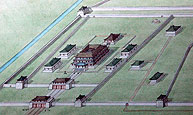
Deluun Boldog, Dadal sum, Hentil prov., on Onon River.


Chingis Khan.
Reproduction of a Chinese “portrait” in a 14th-century Yuan Dynasty album.
Pub. of original: Dschingis Khan, no. 340, p. 304.

Reproduction of a Chinese “portrait” in a 14th-century Yuan Dynasty album.
Pub. of original: Dschingis Khan, no. 341, p. 304.

Reproduction of a Chinese “portrait” in a 14th-century Yuan Dynasty album.
Pub. of original: Dschingis Khan, no. 342, p. 305.


13th-14th c.
Marble. 166 x 76 x 46 cm.
Shonkh Tavan Tolgoi, Dornod prov.
Inv. No. A 282.
Pub. of reprod.: Dschingis Khan, no. 74, p. 99.




Arbulag, Khovsgol Province
Pub.: National Museum, p. 23.

Hogshin Teel, Otorhangai Province



13th-15th c., provenance unknown.
Pub.: National Museum, p. 21; cf. Dschingis Khan, no. 153, p. 176.





For mail shirt, cf. Dschingis Khan, no. 75, p. 99.

13th-century.
Served as base for a stele, no longer extant.
Photo 2005.





Pub. of cauldron: National Museum, p. 24; pub. of analogous wheel bushing: Dschingis Khan, no. 80, p. 101.

Bronze.
Karakorum.
Pub. of analogous weights: Dschingis Khan, no. 178, p. 183.

Bronze.
13th-14th c.
Provenance unknown.
Publ. of analogous mirror: Dschingis Khan, no. 157, p. 177.

Karakorum.
















Pub.: National Museum, p. 24; for other images and discussion of ceramics at Karakorum, see Dschingis Khan, pp. 186-195.




